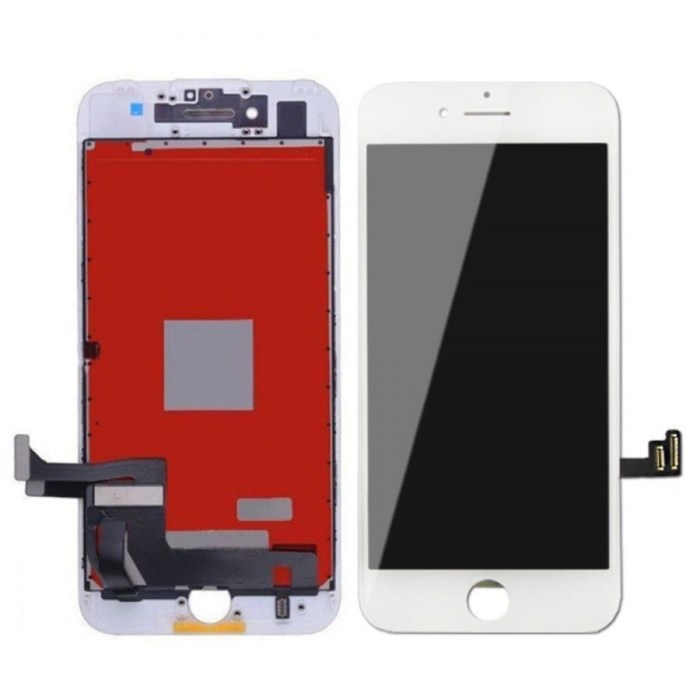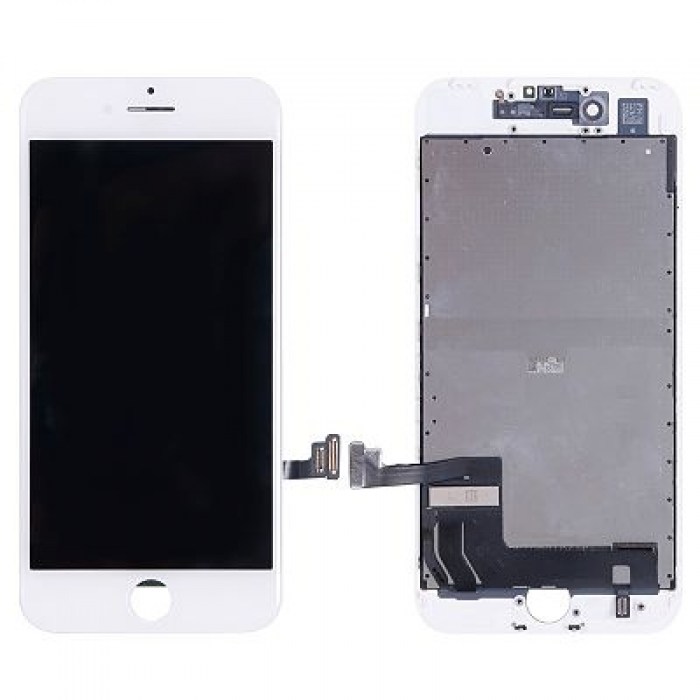The Evolution of iPhone Displays
The iPhone has undergone a significant transformation in its display technology, constantly pushing the boundaries of what’s possible in mobile device screens. From the first iPhone’s LCD to the latest OLED displays, this evolution has been marked by a relentless pursuit of better image quality, energy efficiency, and user experience.
The Evolution of iPhone Displays
The iPhone’s display technology has evolved considerably since its inception. Here’s a timeline showcasing the key milestones:
- iPhone (2007): Introduced a 3.5-inch LCD display with a resolution of 320 x 480 pixels. This display was considered revolutionary for its time, offering a sharp and vibrant viewing experience.
- iPhone 3GS (2009): Featured a 3.5-inch LCD display with a higher resolution of 480 x 320 pixels, providing a clearer and more detailed picture.
- iPhone 4 (2010): Marked a significant leap with its 3.5-inch Retina display, boasting a resolution of 960 x 640 pixels. This display was praised for its incredibly sharp and pixel-dense image, setting a new standard for mobile displays.
- iPhone 5 (2012): Introduced a larger 4-inch Retina display with a resolution of 1136 x 640 pixels. The larger screen size offered a more immersive viewing experience, while the Retina display ensured sharp and detailed visuals.
- iPhone 6 (2014): Introduced a 4.7-inch Retina HD display with a resolution of 1334 x 750 pixels, offering a wider viewing area and enhanced clarity.
- iPhone 6 Plus (2014): Introduced a larger 5.5-inch Retina HD display with a resolution of 1920 x 1080 pixels, providing a truly immersive cinematic experience.
- iPhone 7 (2016): Featured a 4.7-inch Retina HD display with a resolution of 1334 x 750 pixels, offering improved color accuracy and brightness.
- iPhone X (2017): Introduced a 5.8-inch Super Retina HD display with a resolution of 2436 x 1125 pixels. This display was the first OLED display on an iPhone, offering deeper blacks, higher contrast, and wider viewing angles.
- iPhone XS Max (2018): Featured a 6.5-inch Super Retina HD display with a resolution of 2688 x 1242 pixels, providing a truly immersive and cinematic viewing experience.
- iPhone 11 Pro (2019): Introduced a 5.8-inch Super Retina XDR display with a resolution of 2436 x 1125 pixels, offering a wider color gamut, higher peak brightness, and enhanced HDR support.
- iPhone 12 Pro (2020): Featured a 6.1-inch Super Retina XDR display with a resolution of 2532 x 1170 pixels, offering a brighter, more vibrant, and more energy-efficient display.
- iPhone 13 Pro (2021): Featured a 6.1-inch Super Retina XDR display with a resolution of 2532 x 1170 pixels, offering a faster refresh rate of 120Hz for smoother scrolling and animations.
- iPhone 14 Pro (2022): Introduced a 6.1-inch Super Retina XDR display with a resolution of 2556 x 1179 pixels, offering a brighter display with even better HDR support and a new “Always-On” feature.
LCD vs. OLED
The evolution of iPhone displays has also seen a shift from LCD to OLED technology. LCD displays use a backlight to illuminate the screen, while OLED displays use self-illuminating pixels, which allows for deeper blacks, higher contrast, and wider viewing angles.
- LCD: LCD displays are known for their affordability, good color accuracy, and durability. However, they tend to have lower contrast ratios, limited viewing angles, and can suffer from backlight bleed.
- OLED: OLED displays offer superior contrast ratios, deeper blacks, wider viewing angles, and faster response times. They are also more energy-efficient than LCD displays. However, they can be more expensive and susceptible to burn-in if exposed to static images for extended periods.
The Impact of Display Technology Advancements
The advancements in iPhone display technology have significantly impacted user experience and overall smartphone design.
- Improved Image Quality: Higher resolutions and better color accuracy have resulted in more vibrant, detailed, and immersive viewing experiences. This has enhanced the enjoyment of multimedia content, gaming, and even everyday tasks like reading emails.
- Enhanced User Experience: Faster refresh rates have made scrolling and animations smoother, leading to a more responsive and enjoyable user experience. The introduction of features like “Always-On” displays has further enhanced usability and convenience.
- Design Innovation: The transition to OLED displays has enabled thinner and lighter smartphone designs, as well as the implementation of innovative features like edge-to-edge screens and notchless displays.
The iPhone 7 Display in Context
The iPhone 7’s display wasn’t just a pretty face; it was a key component that seamlessly integrated with the phone’s other features, contributing significantly to its overall user experience and market success.
The iPhone 7’s display, a 4.7-inch Retina HD LCD with a resolution of 1334 x 750 pixels, played a crucial role in enhancing the phone’s capabilities, particularly in areas like photography, gaming, and overall user interaction.
The Display’s Impact on Photography
The iPhone 7’s display played a vital role in enhancing the phone’s camera experience. Its bright and vibrant colors, along with its wide viewing angles, provided a clear and accurate preview of the captured image, allowing users to make adjustments before taking the shot. This was particularly important for photographers who relied on the phone’s camera for professional purposes.
The Display’s Role in Gaming
The iPhone 7’s display provided a smooth and immersive gaming experience. Its high refresh rate ensured that fast-paced games were rendered smoothly, without any lag or stuttering. The display’s wide color gamut also enhanced the visual appeal of games, making them more visually engaging.
The Display’s Contribution to User Interaction
The iPhone 7’s display also played a crucial role in improving the phone’s user interface. Its high pixel density and responsiveness ensured that text and icons were displayed sharply and clearly, making the phone easier to use. The display’s multi-touch capabilities also allowed for intuitive interaction with the phone’s software, enhancing the overall user experience.
The Display’s Impact on the iPhone 7’s Success, Iphone 7 has the best lcd display
The iPhone 7’s display was a significant factor in its success in the smartphone market. Its high-quality display, coupled with the phone’s other features, such as its powerful processor and advanced camera, made it a highly desirable device for consumers. The display’s ability to enhance the phone’s overall user experience and appeal to a wide range of users contributed to its popularity and ultimately, its success.
User Feedback and Reviews: Iphone 7 Has The Best Lcd Display
The iPhone 7’s display, while praised for its brightness and color accuracy, also attracted a fair share of user feedback and reviews, both positive and negative. Understanding these user opinions provides valuable insights into the real-world performance and user experience of the display.
User Feedback Themes
User feedback on the iPhone 7’s display reveals several key themes:
- Brightness and Color Accuracy: Many users commended the display’s brightness, especially in outdoor conditions. They also appreciated the vibrant and accurate colors, which enhanced the viewing experience for movies, games, and photos.
- Sharpness and Resolution: The display’s high resolution (1334 x 750 pixels) contributed to a sharp and crisp viewing experience. Users appreciated the clarity and detail of images and text, particularly for reading e-books or browsing websites.
- Viewing Angles: Some users noted that the display’s viewing angles were not as wide as they expected. While colors remained accurate at moderate angles, they could become washed out or distorted at extreme angles.
- Black Levels and Contrast: Users generally found the black levels to be deep and rich, enhancing the overall contrast of the display. This contributed to a more immersive viewing experience, especially for watching movies or playing games.
- Touch Sensitivity and Responsiveness: The display’s touch sensitivity and responsiveness were generally well-received. Users reported smooth scrolling and accurate touch inputs, making the overall user experience seamless.
Pros and Cons of the iPhone 7 Display
The following table summarizes the pros and cons of the iPhone 7’s display based on user feedback:
| Pros | Cons |
|---|---|
| High brightness for outdoor visibility | Limited viewing angles, especially at extreme angles |
| Accurate and vibrant colors | Some users reported screen burn-in issues |
| Sharp and crisp resolution | Not as advanced as newer displays with higher refresh rates |
| Deep black levels and high contrast | |
| Responsive and accurate touch sensitivity |
Sentiment Analysis of User Reviews
A sentiment analysis of user reviews reveals a generally positive sentiment towards the iPhone 7’s display. While some users expressed concerns about viewing angles and potential burn-in issues, the majority praised its brightness, color accuracy, and overall viewing experience.
Iphone 7 has the best lcd display – The iPhone 7’s LCD display wasn’t just a technological achievement; it was a testament to Apple’s commitment to delivering a premium user experience. While OLED displays have since taken the spotlight, the iPhone 7’s LCD remains a reminder that sometimes, the best technology is the one that delivers the best experience. So, if you’re looking for a phone with a classic, high-quality LCD display, the iPhone 7 is still a worthy contender.
The iPhone 7’s LCD display was a game-changer, boasting vibrant colors and incredible clarity. But even the best technology can’t always stop people from getting distracted, like when Pokemon Go hit Taiwan and caused a spike in traffic tickets as drivers got caught up in the virtual world. It just goes to show, even with a phenomenal display, sometimes our attention can wander!
 Standi Techno News
Standi Techno News

